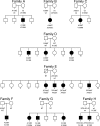Genotype-phenotype correlation in DFNB8/10 families with TMPRSS3 mutations
- PMID: 21786053
- PMCID: PMC3214237
- DOI: 10.1007/s10162-011-0282-3
Genotype-phenotype correlation in DFNB8/10 families with TMPRSS3 mutations
Abstract
In the present study, genotype-phenotype correlations in eight Dutch DFNB8/10 families with compound heterozygous mutations in TMPRSS3 were addressed. We compared the phenotypes of the families by focusing on the mutation data. The compound heterozygous variants in the TMPRSS3 gene in the present families included one novel variant, p.Val199Met, and four previously described pathogenic variants, p.Ala306Thr, p.Thr70fs, p.Ala138Glu, and p.Cys107Xfs. In addition, the p.Ala426Thr variant, which had previously been reported as a possible polymorphism, was found in one family. All affected family members reported progressive bilateral hearing impairment, with variable onset ages and progression rates. In general, the hearing impairment affected the high frequencies first, and sooner or later, depending on the mutation, the low frequencies started to deteriorate, which eventually resulted in a flat audiogram configuration. The ski-slope audiogram configuration is suggestive for the involvement of TMPRSS3. Our data suggest that not only the protein truncating mutation p.T70fs has a severe effect but also the amino acid substitutions p.Ala306Thr and p.Val199Met. A combination of two of these three mutations causes prelingual profound hearing impairment. However, in combination with the p.Ala426Thr or p.Ala138Glu mutations, a milder phenotype with postlingual onset of the hearing impairment is seen. Therefore, the latter mutations are likely to be less detrimental for protein function. Further studies are needed to distinguish possible phenotypic differences between different TMPRSS3 mutations. Evaluation of performance of patients with a cochlear implant indicated that this is a good treatment option for patients with TMPRSS3 mutations as satisfactory speech reception was reached after implantation.
Figures





References
-
- Ahmed ZM, Li XC, Powell SD, Riazuddin S, Young TL, Ramzan K, Ahmad Z, Luscombe S, Dhillon K, MacLaren L, Ploplis B, Shotland LI, Ives E, Riazuddin S, Friedman TB, Morell RJ, Wilcox ER. Characterization of a new full length TMPRSS3 isoform and identification of mutant alleles responsible for nonsyndromic recessive deafness in Newfoundland and Pakistan. BMC Med Genet. 2004;5:24. doi: 10.1186/1471-2350-5-24. - DOI - PMC - PubMed
-
- Ben-Yosef T, Wattenhofer M, Riazuddin S, Ahmed ZM, Scott HS, Kudoh J, Shibuya K, Antonarakis SE, Bonne-Tamir B, Radhakrishna U, Naz S, Ahmed Z, Riazuddin S, Pandya A, Nance WE, Wilcox ER, Friedman TB, Morell RJ. Novel mutations of TMPRSS3 in four DFNB8/B10 families segregating congenital autosomal recessive deafness. J Med Genet. 2001;38:396–400. doi: 10.1136/jmg.38.6.396. - DOI - PMC - PubMed
-
- Bom SJ, De Leenheer EM, Lemaire FX, Kemperman MH, Verhagen WI, Marres HA, Kunst HP, Ensink RJ, Bosman AJ, Van CG, Cremers FP, Huygen PL, Cremers CW. Speech recognition scores related to age and degree of hearing impairment in DFNA2/KCNQ4 and DFNA9/COCH. Arch Otolaryngol Head Neck Surg. 2001;127:1045–1048. - PubMed
-
- Cremers C, Van Rijn P, Ter Haar B. Autosomal recessive progressive high-frequency sensorineural deafness in childhood. Arch Otolaryngol Head Neck Surg. 1987;113:1319–1324. - PubMed
Publication types
MeSH terms
Substances
LinkOut - more resources
Full Text Sources
Other Literature Sources

